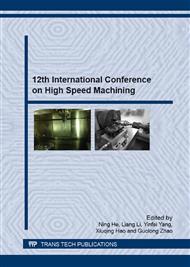p.139
p.147
p.155
p.161
p.168
p.177
p.185
p.191
p.198
Cutting Temperature and Cutting Forces Investigation Based on the Taguchi Design Method when High-Speed Milling of Titanium Matrix Composites with PCD Tool
Abstract:
High-speed milling tests were performed on vol. (5%-8%) TiCp/TC4 composite in the speed range of 50-250 m/min using PCD tools to nvestigate the cutting temperature and the cutting forces. The results showed that radial depth of cut and cutting speed were the two significant influences that affected the cutting forces based on the Taguchi prediction. Increasing radial depth of cut and feed rate will increase the cutting force while increasing cutting speed will decrease the cutting force. Cutting force increased less than 5% when the reinforcement volume fraction in the composites increased from 0% to 8%. Radial depth of cut was the only significant influence factor on the cutting temperature. Cutting temperature increased with the increasing radial depth of cut, feed rate or cutting speed. The cutting temperature for the titanium composites was 40-90 °C higher than that for the TC4 matrix. However, the cutting temperature decreased by 4% when the reinforcement's volume fraction increased from 5% to 8%.
Info:
Periodical:
Pages:
168-174
Citation:
Online since:
January 2016
Authors:
Price:
Сopyright:
© 2016 Trans Tech Publications Ltd. All Rights Reserved
Share:
Citation:


